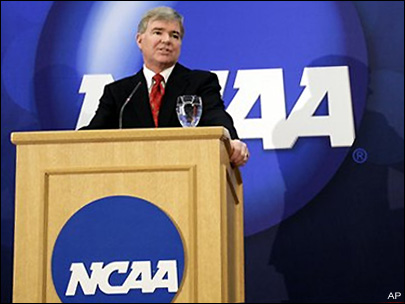Deconstructing the NCAA’s New Penalty Structure
Posted by rtmsf on August 3rd, 2012Christopher Johnson is an RTC columnist. He can be reached @ChrisDJohnsonn.
After meting out unprecedented sanctions just over a week ago against Penn State’s football program in response to the Jerry Sandusky child sexual molestation scandal and alleged cover-up of high ranking officials within the program, it appears the NCAA is leading a charge to ramp up the severity of future penalties in keeping with the precedent established in this watershed case. NCAA leaders reached a consensus Thursday on a new proposal endorsing a revised four-tier penalty structure that includes many of the same punitive measures handed down last week against the Nittany Lions, including hefty fines, up to four years’ postseason ban, and suspensions for head coaches. Far more significant is the radical shift in both the process used to interpret violations and the culpability of coaches in either concealing or enabling forbidden activity. Under the new punishment structure — which is expected to be voted into approval at the Board of Directors’ Meeting in October — coaches will be held accountable for any violations committed by members of their staffs, with suspensions awaiting any coach unable to prove innocence in any wrongdoing.
The new guidelines also call for increasing the size of the infractions committee from 10 to 24 members, a modification designed to streamline the enforcement process, which has been widely denounced in recent years for its lumbering proceedings. In the wake of the most heinous and unconscionable scandal in the history of intercollegiate athletics, these changes provide a measure of legitimacy to the NCAA’s handling of the Penn State scandal and pushback for those who criticized the organization for their misplaced priorities throughout the enforcement process. Many chided NCAA president Mark Emmert for overstepping his bounds in bypassing the infractions committee and fast tracking the harsh punitive measures, fearing he was setting a dangerous precedent with the breadth and severity of the sanctions along with the hasty and unprecedented procedure used to deliver those penalties. By legislating a speedier decision in implementing a harsher punitive scale for violations, the new guidelines represent a step forward in support of Emmert’s recent actions. That NCAA leaders were overwhelmingly supportive of similar measures disputes the notion that Emmert operated without the consent and backing of organization members.
Once it goes into action as soon as 2013, the legislation will serve as a strong policing influence against agents and associated third-party recruiting services who steer elite prospects to the highest bidder. Since taking over as president in November 2010, Emmert has led a renewed focus on harsher and more prohibitive penalties against such third-party activity. The new measures, perhaps more than any enforcement mechanism of years past, will provide a strong disincentive for coaches who use the influence of their services to rein in top high-school talents on the recruiting trail. Whereas in the past coaches could always shoulder blame on a staff member or simply feign innocence — and most of the time, get away relatively unharmed by pursuing either option — association with third-party services now carries a far greater risk. As mentioned above, coaches would be “presumed responsible for any violations committed by their staffs.” Given the outsized influence of hired recruiting services in today’s college hoops recruiting landscape — a coach recently told CBSSports’ Gary Parrish that “99.9 percent” of coaches use third-party recruiters — the new regulations could result in harsher penalties for head coaches; or, in a perfect world, a near elimination of those third-party services altogether.
Which brings me, in a roundabout way, to the recent news involving Central Florida — college sports’ recruiting violation scandal du jour. The Knights, as reported Tuesday by Pete Thamel of the New York Times, will face stiff penalties for their involvement with agent Keith Caldwell, who funneled football and men’s basketball recruits to Central Florida from the fertile Chicago-area recruiting grounds. UCF received the dreaded Lack of Institutional Control charge for its illicit behavior, and will receive a one-year bowl ban, one-year men’s basketball tournament ban, five years’ probation, a $50,000 fine, scholarship reductions and recruiting restrictions as a result. The NCAA also announced show-cause orders for former athletic director Keith Tribble — who reportedly maintained a close friendship with Caldwell and encouraged his recruiting tactics — and head basketball coach Donnie Jones. Needless to say, the punishments are extensive and debilitating. The Knights must now limp out of their final season in Conference USA and embrace an unceremonious entry in 2013 into a new league, the Big East.
Still, given the hefty punitive upgrades stipulated by the NCAA’s new punishment structure, the Knights got off relatively easy, all things considered. Had the violations come to light under the rule of the new guidelines, UCF likely would have faced sanctions far more damaging than the announced penalties. UCF’s violations — widespread knowledge and complicity at the highest levels of leadership in facilitating agents and third-party runners — would have been a textbook case in allowing the NCAA to flex its new and improved punitive muscle. The proposal may be strict and unfair on some levels, but the only way to eliminate these sorts of violations is by increasing the effectiveness and force of disciplinary procedure. The new punishment structure, on its own merits, will not strip an inherently competitive recruiting market of third-party influences and agents. It will raise the costs for the fearless programs choosing to use them.











































